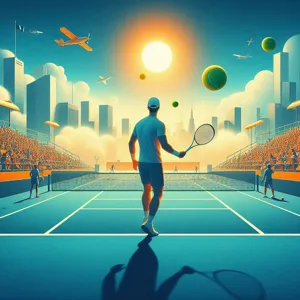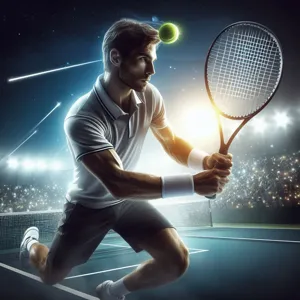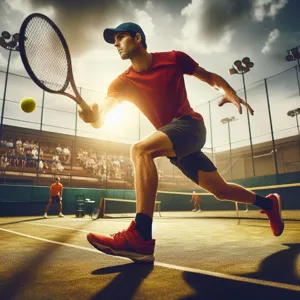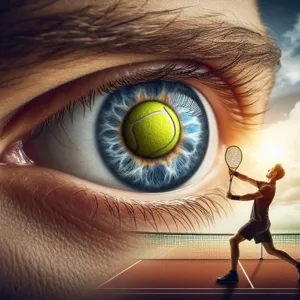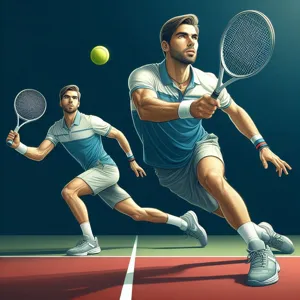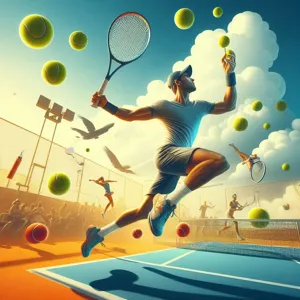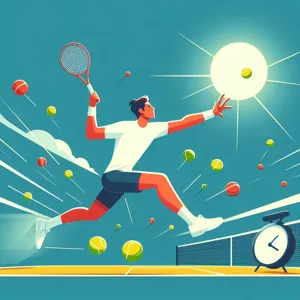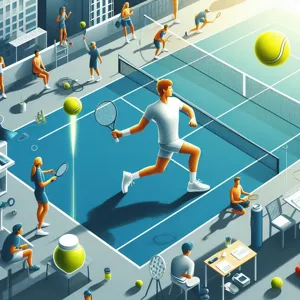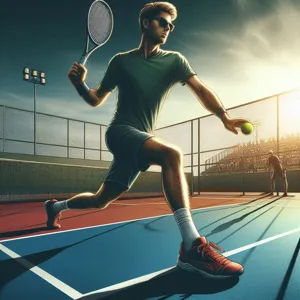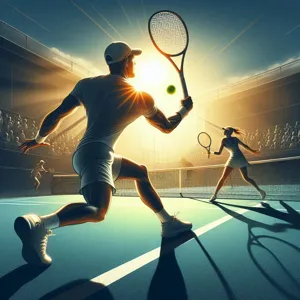Tennis is much more than a game of skill; it’s a battle of strategy and mental fortitude, where every serve and volley can shift the tide of the match.
Whether you’re a seasoned player or just picking up a racket, having a solid game plan is essential for mastering the court. In this blog post, we’ll explore the top tips that will not only enhance your technique and physical performance but also sharpen your strategic thinking. From understanding your opponent’s weaknesses to developing your own strengths, we’ll delve into the fundamentals of effective preparation and in-match adjustments. So grab your tennis shoes and get ready to elevate your game—because mastering your match means playing smarter, not just harder!
1. Understanding the Importance of a Game Plan

In the world of tennis, where split-second decisions can determine the outcome of a match, having a well-crafted game plan is crucial. A game plan acts as your strategic blueprint, guiding you through the complexities of each encounter on the court. It’s not just about the strokes you can hit or the serves you can deliver; it’s about understanding your opponent, adapting to their style, and optimizing your strengths to gain the upper hand.
When you step onto the court without a game plan, you risk becoming reactive rather than proactive. The best players know that each match is a unique puzzle, and having a strategy allows them to approach it with confidence and clarity. By analyzing your opponent’s weaknesses and your own strengths, you can create a tailored approach that maximizes your chances of success. This might include specific shot selections, positioning strategies, or even psychological tactics to unsettle your rival.
Furthermore, a game plan provides structure to your play, helping you remain focused even in the heat of competition. It allows you to anticipate scenarios, make calculated risks, and adjust your strategy as the match unfolds. Remember, tennis is as much a mental game as it is a physical one. By having a clear game plan, you empower yourself to stay calm under pressure, maintain your composure, and make strategic decisions that can turn the tide in your favor.
As you prepare for your next match, take the time to develop a solid game plan. Assess your strengths, analyze your opponent, and outline your objectives. By doing so, you’ll not only play with purpose but also elevate your game to new heights. After all, in tennis, mastering your match starts with mastering your strategy.
2. Assessing Your Strengths and Weaknesses
Before stepping onto the court, it’s crucial to conduct a thorough assessment of your strengths and weaknesses as a player. This self-evaluation not only equips you with the knowledge necessary to devise a winning game plan but also enhances your overall performance and confidence during matches.
start by identifying your strongest shots. Do you have a powerful serve that can dominate your opponent? Maybe your backhand is a reliable weapon that allows you to control rallies. Take note of these assets, as they will form the backbone of your strategy. On the flip side, be honest about your weaknesses. Is your forehand inconsistent? Do you struggle with net play? Recognizing these areas gives you the opportunity to adjust your game plan accordingly and focus your practice sessions on improvement.
Additionally, consider how your physical attributes influence your play. Are you quick on your feet, allowing you to chase down balls with ease? Or do you have a strong sense of positioning that helps you anticipate your opponent’s shots? Understanding how your physicality interacts with your skill set can inform your tactical approach. For instance, if you’re agile, you might want to adopt a more aggressive style, taking control of the net. Conversely, if you have a powerful baseline game but lack speed, a more defensive strategy might be in order, waiting for your opponent to make errors.
Remember, assessing your strengths and weaknesses isn’t just a one-time exercise. Continually reevaluate your game as you progress, adjusting your strategies to reflect your growth as a player. By having a clear picture of where you excel and where you can improve, you’ll not only boost your performance but also approach every match with a strategic mindset that can lead you to victory. This self-awareness will provide the foundation for a game plan tailored to your unique abilities, setting you up for success on the court.
3. Analyzing Your Opponent’s Playing Style

Analyzing your opponent’s playing style is a crucial component of developing a game plan that can lead you to victory on the tennis court. Every player has unique strengths, weaknesses, and tendencies that can be exploited with the right strategy. To effectively analyze your opponent, start by observing their serve. Are they dominant with their first serve, or do they rely on consistency with their second? Take note of the placement—do they favor the corners, or do they tend to hit down the middle? Understanding their serving patterns can give you insight into how to position yourself effectively for the return.
Next, pay attention to their groundstrokes. Is your opponent aggressive, frequently hitting with pace and depth, or do they prefer to play it safe with softer shots that allow for longer rallies? look for patterns in their shot selection. Do they frequently use cross-court shots, or do they like to go down the line? This can inform your positioning and readiness during the match. Additionally, consider their movement around the court. Are they quick and agile, or do they struggle to cover the baseline? If they have a slower foot speed, you may want to employ a strategy that utilizes drop shots or angled shots to draw them out of position.
Don’t forget to analyze their mental game as well. Some players become frustrated easily, while others maintain a calm demeanor no matter the situation. If you notice signs of frustration, you might exploit this by playing strategically to increase the pressure. Conversely, if your opponent thrives under pressure, be prepared to play conservatively and strategically to nullify their momentum.
By thoroughly analyzing your opponent’s playing style, you can craft a tailored game plan that not only plays to your own strengths but also targets their vulnerabilities. This approach not only boosts your confidence on the court but also enhances your ability to adapt and respond during the match, ultimately leading to a stronger performance and increased chances of success.
4. Setting Clear Goals for the Match
Setting clear goals for the match is a foundational step in developing an effective game plan. Without a defined target, even the most skilled player can find themselves wandering aimlessly on the court, missing opportunities and failing to capitalize on their strengths. Before you step onto the court, take a moment to reflect on what you want to achieve during the match. Are you aiming to improve your serve percentage, enhance your net play, or perhaps focus on maintaining a steady rally?
By establishing specific, measurable goals, you create a roadmap that guides your strategy throughout the match. For instance, if your goal is to hit at least 60% of your first serves in, you can adjust your warm-up sessions to emphasize serving drills and ensure your confidence is high when it’s time to serve. Similarly, if you aim to dominate points at the net, you might prioritize approaching after your groundstrokes and practicing quick transitions during warm-ups.
It’s also essential to have both short-term and long-term goals. Short-term goals could vary from winning the first set to executing a particular shot under pressure, while long-term goals might involve developing your overall fitness or improving your match endurance over the course of the tournament.
Remember, these goals should be realistic and catered to your current skill level. This way, they serve as motivation rather than sources of frustration. As you progress through the match, periodically assess your performance against your goals. Are you sticking to your game plan? If not, what adjustments can you make to realign with your objectives? By keeping your goals at the forefront of your mind, you not only enhance your competitive edge but also cultivate a sense of focus and purpose that can significantly elevate your game. Ultimately, setting clear goals transforms each match into an opportunity for growth, making every point played a stepping stone towards not just winning, but mastery of the sport.
5. Developing a Strategic Serve

The serve is often referred to as the most crucial shot in tennis, setting the tone for the entire match. Developing a strategic serve is not just about power; it’s about precision, placement, and reading your opponent. A well-executed serve can put you in control right from the first point, dictating the pace and rhythm of the game.
To master your serve, start by experimenting with different types: flat serves, slice serves, and kick serves. Each serves a unique purpose—while a flat serve can be a powerful weapon to catch your opponent off guard, a slice serve can create angles that make it difficult for them to return the ball effectively. The kick serve, with its high bounce, can disrupt your opponent’s timing and positioning, especially on a second serve.
In addition to varying your serve types, focus on placement. Targeting specific areas of the service box can keep your opponent guessing and off balance. Aim for the corners, the body, or even throw in a surprise serve to their weaker side. The element of surprise can be your best ally; if your opponent anticipates the same serve repeatedly, they’ll quickly adjust their positioning and strategy.
It’s also essential to incorporate a mental strategy into your serving game. Before serving, assess your opponent’s weaknesses and tendencies. Are they more comfortable returning serves to their forehand or backhand? Do they struggle with low balls or high bounces? Use this information to tailor your serves specifically to exploit these weaknesses.
Lastly, don’t overlook the importance of practice. Regularly dedicate time to refining your serve technique, focusing on your toss, stance, and follow-through. The more consistent you become, the more confident you’ll feel during matches. With a strategic serve in your arsenal, you’ll not only enhance your game but also increase your chances of outmaneuvering your opponent right from the start.
6. Crafting a Winning Return Strategy
Crafting a winning return strategy is essential for any tennis player looking to elevate their game and dominate the court. The return of serve is a critical moment in a match, as it sets the tone for the rally and can determine the outcome of the point. To effectively counter your opponent’s serve, you need to analyze their serving patterns and develop a personalized approach that aligns with your strengths.
Start by observing your opponent’s serving habits. Are they more likely to serve wide on the deuce side, or do they favor a powerful down-the-middle serve? By identifying these tendencies, you can position yourself accordingly and anticipate their next move. A well-placed return can put pressure on your opponent, forcing them to react rather than dictate the point.
In addition to understanding your opponent, consider your own playing style. Are you more comfortable with aggressive returns that put your opponent on the defensive, or do you prefer to play it safe with deep, consistent shots? Tailor your return strategy to maximize your strengths. If you excel at attacking the net, practice hitting deep returns that allow you to transition quickly into an offensive position. Conversely, if you’re a baseline player, focus on consistent, high-bouncing returns that give you time to set up for the next shot.
Timing is another crucial element in crafting your return strategy. The moment the ball leaves your opponent’s racket, make a split-second decision on how to respond. Aim to strike the ball at its peak height, which will give you better control and the ability to direct your shots more effectively. Practice your footwork to ensure you can position yourself optimally for a powerful return, whether it’s a forehand or backhand.
Lastly, don’t underestimate the psychological aspect of the return. Confidence can significantly impact your performance, so approach each serve as an opportunity to assert your dominance on the court. Visualize successful returns before the match and remind yourself that each return is a chance to take control of the point. With a well-thought-out return strategy, you can turn the tables on your opponent and give yourself the best chance for success in every match.
7. Utilizing Court Positioning to Your Advantage

Court positioning is a crucial yet often overlooked aspect of tennis strategy that can significantly impact the outcome of your match. Understanding where to stand on the court in relation to your opponent’s positioning and the ball’s trajectory can give you a distinct edge.
As a general rule, aim to maintain a balanced position that allows for both offensive and defensive plays. When your opponent is at the baseline, consider inching slightly forward to cut off their angles and prepare for a potential volley. Conversely, if they’re pressed against the net, retreating a few steps can provide you with the necessary space to execute a powerful shot or a well-placed lob.
Additionally, positioning yourself towards the center of the court can enhance your ability to respond to your opponent’s shots effectively. By staying closer to the middle, you minimize the distance you need to cover, allowing for quicker reactions and better placement of your returns. Don’t underestimate the value of lateral movement; being able to slide quickly to the side can help you intercept balls that might otherwise be out of reach.
Moreover, consider the importance of anticipating your opponent’s shots based on their body positioning and racket angle. If they seem poised to hit cross-court, shifting your weight and positioning yourself accordingly can prepare you for a more strategic return.
Lastly, remember that court positioning is not static; it should evolve throughout the match based on your opponent’s strengths and weaknesses. Observing their tendencies will allow you to adjust your positioning dynamically, keeping them guessing and giving you the upper hand. By harnessing the power of strategic court positioning, you can turn the tide in your favor and play with a confidence that stems from being in control of the game.
8. Incorporating Variety in Your Shots
In the dynamic world of tennis, predictability can be your greatest enemy. To keep your opponent on their toes and elevate your game, incorporating variety in your shots is essential. A well-rounded player knows how to mix things up, utilizing an array of strokes that not only showcase their skill but also disrupt their opponent’s rhythm.
Start by mastering the basics: forehands, backhands, volleys, and serves. However, the real magic happens when you begin to blend these techniques with strategic variations. For instance, while a powerful first serve can set the tone, following it up with a drop shot or a slice serve can throw your opponent off balance, forcing them to adapt to your changing pace and spin.
Incorporating topspin can help you maintain control while adding depth to your shots. By varying the height and angle of your shots, you can push your opponent back or draw them forward, creating openings for a decisive volley or smash. Additionally, consider employing angles; a sharp cross-court shot can create unexpected opportunities, while a well-placed down-the-line shot can catch your opponent flat-footed.
Don’t forget the importance of rhythm and timing. By changing the tempo of your shots, you can disrupt your opponent’s timing, making it difficult for them to anticipate your next move. Remember, the key is to keep your adversary guessing—an unpredictable player is often a formidable one.
As you practice, pay attention to how different shot variations can be integrated into your overall game plan. Keep challenging yourself to experiment with different combinations during drills, and observe how they affect your performance in matches. With a repertoire of diverse shots at your disposal, you’ll not only enhance your own gameplay but also increase the likelihood of outsmarting your opponent, ultimately mastering your match.
9. Managing Your Mental Game
Managing your mental game is just as crucial as honing your physical skills on the tennis court. The mental aspect of tennis can often be the deciding factor between victory and defeat. A strong mindset enables you to stay focused, handle pressure, and recover from setbacks during a match.
First and foremost, visualization is a powerful tool. Before stepping onto the court, take a few moments to envision your ideal performance. Picture yourself executing your serves, returning shots with precision, and celebrating points won. This mental rehearsal not only boosts your confidence but also prepares your subconscious to respond positively when faced with real match situations.
Equally important is the ability to stay present. Tennis can be a whirlwind of emotions, from the thrill of winning a point to the frustration of an unforced error. To maintain your composure, practice mindfulness techniques that help you focus on the current point rather than dwelling on past mistakes or worrying about future outcomes. Simple deep-breathing exercises can ground you and bring clarity when the pressure mounts.
Additionally, developing a pre-match routine can significantly enhance your mental state. Whether it’s listening to your favorite pump-up playlist, engaging in light stretching, or visualizing your strategy, a consistent routine can help you enter the match with a calm and focused mindset.
Lastly, embrace the power of positive self-talk. Replace any negative thoughts with encouraging affirmations. Remind yourself of your strengths and past successes; each time you hear your inner critic, counter it with a positive statement. By fostering a constructive dialogue with yourself, you can build resilience and maintain focus throughout the match.
In the end, mastering the mental game is about cultivating a mindset that thrives under pressure, allowing you to execute your game plan with confidence and poise. Remember, tennis is as much a mental battle as it is a physical one, and by managing your mental game effectively, you’re laying the groundwork for success on the court.
10. The Role of Physical Fitness in Tennis Performance
When it comes to excelling in tennis, physical fitness is not just an ancillary aspect; it’s a cornerstone of peak performance. The sport demands a unique blend of strength, endurance, agility, and flexibility, all of which are critical for executing powerful serves, quick volleys, and strategic court coverage. As you step onto the court, your fitness level can significantly influence not only your stamina but also your ability to maintain focus and execute your game plan effectively.
To enhance your performance, it’s essential to integrate a well-rounded fitness regimen into your training routine. Focus on cardiovascular exercises, such as running or cycling, to build endurance that will allow you to keep up with fast-paced rallies and long matches. Strength training is equally important; targeted exercises for your legs, core, and upper body will increase your power, enabling you to hit with more force and control. Don’t underestimate the importance of flexibility; incorporating stretching and yoga can improve your range of motion, helping you reach those challenging shots without risking injury.
Moreover, agility drills, such as ladder exercises or cone sprints, can sharpen your footwork, allowing for quicker transitions around the court. As you hone your physical fitness, you’ll discover that your ability to anticipate your opponent’s moves improves, enabling you to position yourself advantageously for each stroke.
In essence, mastering your match goes beyond just technical skills; it requires a commitment to fitness that will elevate your game. The stronger, faster, and more agile you become, the better equipped you’ll be to implement your strategies effectively, outlast your opponents, and emerge victorious on the court.
11. Adjusting Your Game Plan Mid-Match
Adjusting your game plan mid-match is a crucial skill that separates seasoned players from novices. As any experienced tennis player will tell you, the dynamics of a match can shift dramatically with every serve, volley, and rally. It’s essential to remain adaptable and responsive to both your own performance and that of your opponent.
Begin by closely observing your opponent’s strengths and weaknesses. Are they consistently missing their backhand shots? Perhaps their serve lacks power when they’re under pressure? Use this information to pivot your strategy. For example, if your opponent struggles to return low balls, adjust your shots to keep the ball closer to the ground, forcing them to play outside their comfort zone.
Moreover, pay attention to your own game. If you find that your usual strategies aren’t yielding the expected results, don’t hesitate to switch things up. Maybe your serve isn’t landing as effectively as you’d hoped, or your forehand isn’t producing the desired pace. In this case, consider varying your serve with a mix of spins and placements, or incorporate more slice shots to disrupt your opponent’s rhythm.
Communication with your coach or support team between sets can also provide valuable insights. They might spot patterns you’ve missed or suggest tactical adjustments based on their observations. Remember, the key to a successful match lies not just in executing a predetermined game plan, but in your ability to read the situation and adjust accordingly.
Embrace the unpredictability of your matches and develop a mindset that is flexible and strategic. By honing your ability to adapt mid-match, you’ll not only enhance your performance but also increase your chances of securing victory on the court.
12. Importance of Practice and Drills
When it comes to mastering your game on the tennis court, the importance of practice and drills cannot be overstated. Just like any other sport, tennis requires a dedicated commitment to honing your skills, and the most successful players understand that consistent practice is the foundation of excellence.
Engaging in targeted drills can significantly enhance your playing techniques, from improving your serve to perfecting your backhand. For instance, repetitive drills focusing on your footwork can help you develop agility and speed, allowing you to position yourself better for each shot. Similarly, practicing your serve in isolation can help you build confidence and precision, turning what could be a point of weakness into a formidable strength during matches.
Moreover, practice isn’t just about hitting balls back and forth; it’s about simulating game conditions. Incorporating match-like scenarios into your practice sessions can prepare you mentally and physically for the challenges you’ll face during actual matches. This might involve setting specific scoring objectives, playing against opponents of varying skill levels, or practicing under pressure by timing your sessions or introducing competitive elements.
Remember, quality matters just as much as quantity. Focused, intentional practice sessions where you set clear goals will yield far better results than simply hitting balls without a plan. By committing to regular drills and practice routines, you’ll not only refine your technique but also develop the mental fortitude needed to execute your game plan effectively when it counts the most. So lace up your shoes, grab your racquet, and embrace the transformative power of practice—your future self on the court will thank you.
13. Learning from Each Match: Post-Game Analysis
Post-game analysis is a vital aspect of mastering your tennis game, and it often separates the amateurs from the true competitors. After each match, whether victorious or defeat, take the time to reflect on your performance. This reflective practice can be as simple as jotting down notes immediately after you leave the court or as structured as discussing key points with a coach or fellow player.
Start by evaluating the overall flow of the match. Did you maintain control during critical points, or did you falter under pressure? Take note of your strengths—perhaps your serve was particularly effective, or your baseline game was solid. Celebrate these successes, as they form the foundation upon which you can build your future strategies.
Conversely, acknowledge the areas where you struggled. Did you find yourself consistently losing points on your backhand, or did you miss crucial opportunities at the net? Be honest with yourself, as this humility is essential for growth. Analyzing aspects like shot selection, footwork, and mental resilience can reveal patterns that you may not have noticed during the heat of the match.
Utilize video analysis if possible. Recording your matches and reviewing them can bring a new perspective, allowing you to visualize your gameplay and identify both tactical errors and successful moves. Consider seeking feedback from your coach or experienced players who can offer insights that you might not have considered.
Finally, create a plan for improvement based on your analysis. Set specific, measurable goals for your next training sessions—whether it’s improving your first serve percentage or working on your movement around the court. By treating each match as a learning opportunity, you not only enhance your skills but also cultivate a mindset geared towards continuous improvement. This commitment to post-game analysis will ensure that with every match you play, you’re not just participating—you’re evolving into a more strategic and formidable competitor on the court.
14. Staying Positive and Focused During the Match
Staying positive and focused during a tennis match can be the difference between victory and defeat. The mental aspect of tennis is just as critical as your physical skills, and maintaining a positive mindset can help you navigate the ebbs and flows of the game. As the match progresses, it’s easy to get caught up in mistakes or become frustrated with your opponent’s play. However, it’s essential to remember that every point is a new opportunity.
To cultivate positivity on the court, start by establishing a pre-match routine that centers you. This might include visualizing your best shots, setting clear goals for your performance, or even repeating a personal mantra to empower yourself. During the match, focus on your breathing—deep, controlled breaths can help calm your nerves and restore your concentration when the pressure mounts.
When you find yourself facing a tough moment, instead of dwelling on a missed shot or a lost game, redirect your thoughts to what you can learn from the experience. Use positive self-talk to reinforce your confidence. Phrases like “I am capable,” or “I’ve trained for this,” can help shift your mindset from one of doubt to determination.
Additionally, staying engaged with the match itself can foster a sense of flow that keeps negativity at bay. Concentrate on each point, celebrating small victories—a well-placed serve or a successful volley—no matter how minor they may seem. This focus not only improves your performance but also enhances your enjoyment of the game.
Remember, tennis is as much a mental battle as it is a physical one. By embracing a positive attitude and maintaining your focus through each point, you not only improve your chances of winning but also foster a deeper love for the sport. Ultimately, the ability to stay positive in the face of adversity will not only serve you well on the court but will also translate into other areas of your life. So, the next time you step onto that court, bring your best attitude, stay present, and watch your game transform.
15. Building Confidence Through Preparation
Building confidence through preparation is a pivotal aspect of excelling in tennis, as it lays the groundwork for a successful match. The more thoroughly you prepare, the more self-assured you’ll feel on the court. This preparation encompasses a variety of elements, from physical conditioning to mental readiness.
Start with your physical training: committing to a regular practice schedule helps develop not just your technique, but also your stamina and strength. Focus on drills that enhance your footwork, serve, and stroke accuracy. The more familiar you become with your shots, the more confident you will feel executing them during a match. Incorporating match simulations into your practice can also be an invaluable tool. Playing practice sets against different opponents helps you adapt to various playing styles and situations, reinforcing your readiness for any challenge.
Mental preparation is equally crucial. Visualize your matches before stepping onto the court—imagine yourself executing perfect serves, making strategic plays, and celebrating well-earned points. This mental rehearsal not only prepares you for the physical aspects of the game but also instills a sense of calm and confidence. Additionally, developing a match strategy based on your strengths and your opponent’s weaknesses can give you a clear game plan to follow, reducing uncertainty when the pressure is on.
Finally, don’t underestimate the power of positive self-talk. Encourage yourself with affirmations and reminders of your past successes. This mental conditioning can shift your mindset from doubt to determination, ensuring that when the time comes to compete, you step onto the court not just prepared, but brimming with the confidence that comes from knowing you’ve done the work to succeed. Remember, confidence isn’t simply a feeling; it’s a mindset cultivated through diligent preparation. With each practice session and every match played, you’ll find yourself stepping up to the baseline with an unshakeable belief in your ability to master the game.
In conclusion, mastering your match with a well-thought-out game plan can be the difference between a good performance and a great one on the tennis court. By implementing the strategies we’ve discussed—ranging from understanding your opponent’s weaknesses to honing your mental toughness—you’ll be better equipped to navigate the challenges of each match. Remember, every great athlete knows that success is not just about skill, but also about preparation and adaptability. So, the next time you step onto the court, do so with confidence and a clear strategy in mind. May your serves be powerful, your volleys precise, and your matches victorious. Happy playing, and we can’t wait to hear about your successes on the court!

